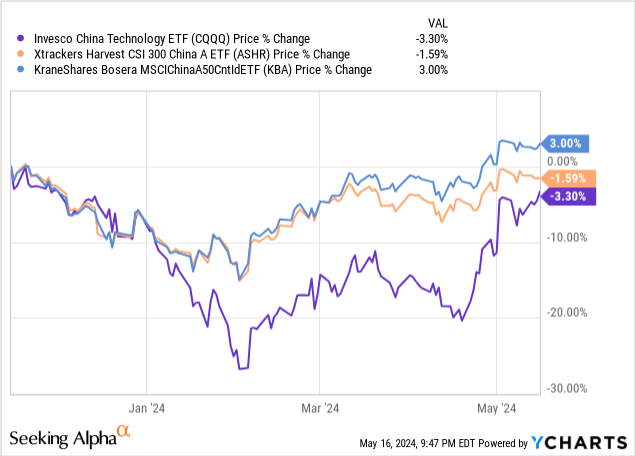


Smederevac
Chinese equities may have bounced strongly off this year’s lows, but there’s been little indication of a macro turnaround so far. Inversely, there’s been more bad news than good, with the country posting a sequential decline in credit growth, as well as flat to mild deflation on its consumer and producer prints.
For markets, though, there is a ‘bad news is good news’ silver lining via more policy support. Last month’s pro-growth Politburo meeting was a case in point on the fiscal side, as was subsequent news flow about even more property support and this week’s special bond issuance. On the monetary side, the combination of poor credit growth, a persistent deflationary bias, and reduced currency pressures (more so after this week’s US data) means bigger and faster rate cuts are on the table. Calls for “reasonably ample liquidity” and a commitment to lower funding costs for corporates and households (per the central bank’s Q1 2024 monetary policy report) only reinforce the case for more monetary easing.
I’ve stressed my preference for playing the policy support theme via Chinese A-shares (see KBA: Still A Compelling Play On China’s Market Revival), and so far, it’s paid off. Looking through the broader Chinese outperformance, though, there have been laggards, and in this regard, the tech sector stands out. Thus, playing the tech ‘catch up’ seems very appealing here, particularly via the more diversified Invesco China Technology ETF (NYSEARCA:CQQQ), which has balanced exposure to both the A-share and offshore legs.

Invesco’s China Technology ETF stands out for its single-sector exposure to China’s tech sector, as well as its wide-ranging market access. For context, the fund holds offshore Hong Kong listings and depositary receipts (US-listed and global), as well as mainland listings (A-shares). The other differentiator for CQQQ is its relative diversification – achieved via a broader 155-stock portfolio and a far stricter weightage policy than other China tech trackers. Key weightage limits include a 10% cap to the fund’s single-stock exposure, as well as a cumulative 40% cap for all individual holdings with a >5% allocation.
While this isn’t the cheapest single-country fund out there, its ~0.65% total expense ratio is very competitive vs key China tech ETF comparable, KraneShares’ CSI China Internet ETF (KWEB). Where CQQQ lags, however, is on liquidity – a result of its smaller asset base at $682m (vs. $6.2bn for KWEB). Still, the ~5bps bid/ask spread difference is offset by the fund’s lower fees, so for longer-term investors moving smaller volumes, CQQQ comes out slightly ahead on overall cost.
|
Total Assets (USD’ m) |
Median Bid/Ask Spread |
Total Expense Ratio |
|
|
Invesco China Technology ETF |
682.1 |
0.09% |
0.65% |
|
KraneShares CSI China Internet ETF |
6,232.0 |
0.04% |
0.69% |
Source: Invesco, KraneShares
For a sector-specific ETF, the CQQQ portfolio is quite broad at 155 holdings – by comparison, KWEB maintains a far narrower 35-stock portfolio. As for the sub-sector breakdown, CQQQ is also better balanced, with its largest exposure, Interactive Media & Services, limited to 27.4% (per the fund’s latest disclosure). Semiconductors & Semiconductor Equipment (20.7%) is the other big sub-sector allocation, followed by Electronic Equipment, Instruments & Components (13.2%), Broadline Retail (10.4%), and Software (10.4%). By comparison, KWEB, by virtue of its internet focus, is almost exclusively concentrated in Interactive Media & Services.
|
Sub-Sector |
Holding |
|
Interactive Media & Services |
27.4% |
|
Semiconductors & Semiconductor Equipment |
20.7% |
|
Electronic Equipment, Instruments & Components |
13.2% |
|
Broadline Retail |
10.4% |
|
Software |
10.4% |
|
Hotels, Restaurants & Leisure |
8.1% |
|
Entertainment |
3.5% |
|
Electrical Equipment |
1.7% |
|
IT Services |
1.4% |
|
Technology Hardware, Storage & Peripherals |
1.3% |
|
Media |
1.2% |
|
Capital Markets |
0.5% |
|
Consumer Staples Distribution & Retail |
0.1% |
|
Trading Companies & Distributors |
0.1% |
|
Textiles, Apparel & Luxury Goods |
0.1% |
|
Total |
100.0% |
Source: Invesco Schedule of Investments
As CQQQ draws from a different universe of eligible stocks (FTSE China Index and FTSE China A Stock Connect CNH Index), the fund doesn’t have a standard China ‘big tech’ allocation. Yes, Tencent (OTCPK:TCEHY) is, like KWEB and many other China funds, the largest holding at an outsized 12.4%. The most notable omission, however, is Alibaba (BABA), while the relative overweights on search engine company Baidu (BIDU) and short video platform Kuaishou (OTCPK:KUASF) highlight CQQQ’s different approach to ‘big tech’ in China. Beyond the top five, CQQQ also branches out much further beyond the standard internet names, for instance, via exposure to the domestic tech supply chain (Sunny Optical) and software (Kingdee International and Kingsoft). Thus, on the whole, CQQQ is a much better representation of China’s tech sector vs KWEB, which focuses specifically on internet names.
Also notable is that CQQQ retains a lot more A-share exposure than KWEB, though both funds still have some HFCAA-related (‘Holding Foreign Companies Accountable Act’) delisting risk via their American depositary receipt holdings. That said, the lack of initiative from CQQQ in de-risking the portfolio (see graphic below for KWEB’s efforts) is a negative, particularly in light of geopolitical tensions. A more proactive effort by CQQQ to convert their ADRs to equivalent Hong Kong listings would, therefore, be a positive step.
Much like the broader China markets, CQQQ has been a serial destroyer of shareholder value in recent years. Unlike more straightforward China trackers, though, CQQQ, by virtue of its tech focus, has recovered at a much slower pace after this Chinese New Year. As a result, the one, three, and five-year track records now stand at -18.1%, -25.4%, and -7.6%, respectively. Key comparable, KWEB, which leans more toward offshore internet listings, has annualized at a similar three and five-year pace. Where both funds diverge, though, is the near-term performance, with CQQQ running well below both KWEB and MSCI China trackers at -5.0% year-to-date.
It’s worth noting, though, that CQQQ’s underperformance is down to sector-wide trends rather than the fund manager. After adjusting for fees, the fund has tracked its benchmark FTSE China Incl A 25% Technology Capped Index very closely – despite bouts of market volatility and the execution required to maintain its weightage caps.
The other key positive is CQQQ’s earnings growth outlook, which ranks right at the top of the China ETF universe at over 50% (vs low teens % for MSCI China). And unlike KWEB’s internet-focused portfolio, the sustainability of CQQQ’s ex-internet earnings growth (think semiconductors, supply chain, etc.) is easier to underwrite, given its strategic alignment with central government policy goals. So in context, the ~20x forward earnings multiple is not all that expensive, in my view, particularly with more market-related policy support in the pipeline (e.g., a “Nine-Point Guideline” to unlock corporate value).
China’s macro hasn’t yet recovered, but stocks have rallied anyway, partially on valuations and partially on monetary/fiscal easing hopes. Yet, tech has lagged on the way up – despite offering among the highest earnings growth rates and sensitivity to future easing. Many tech names are also both cash-generating and overcapitalized, so a meaningful step up in share buybacks or dividends (key goals of China’s upcoming market reforms) could drive a lot more outperformance. Given its balanced onshore/offshore exposure, CQQQ stands out as a great way to play the tech ‘catch up’ trade.